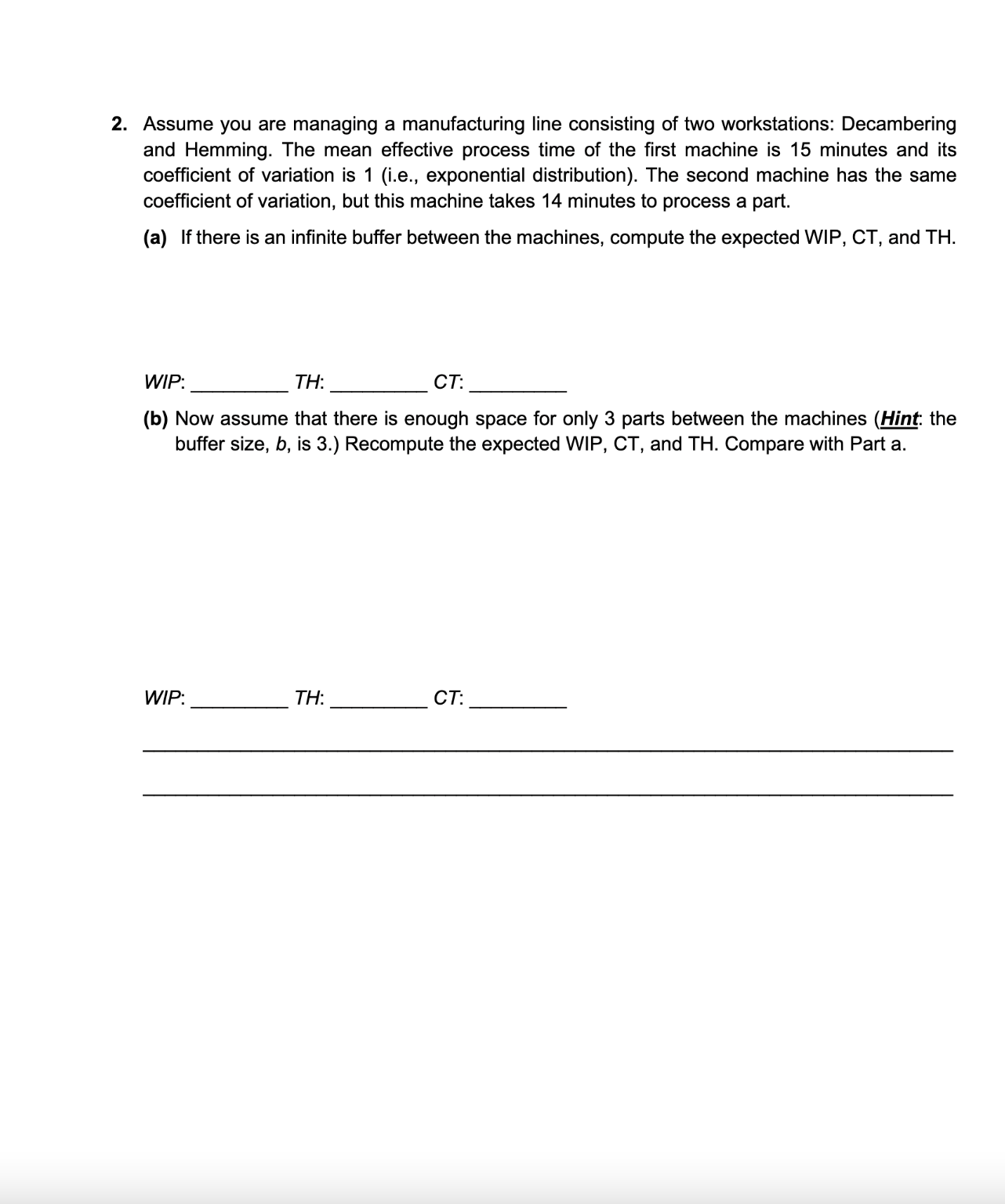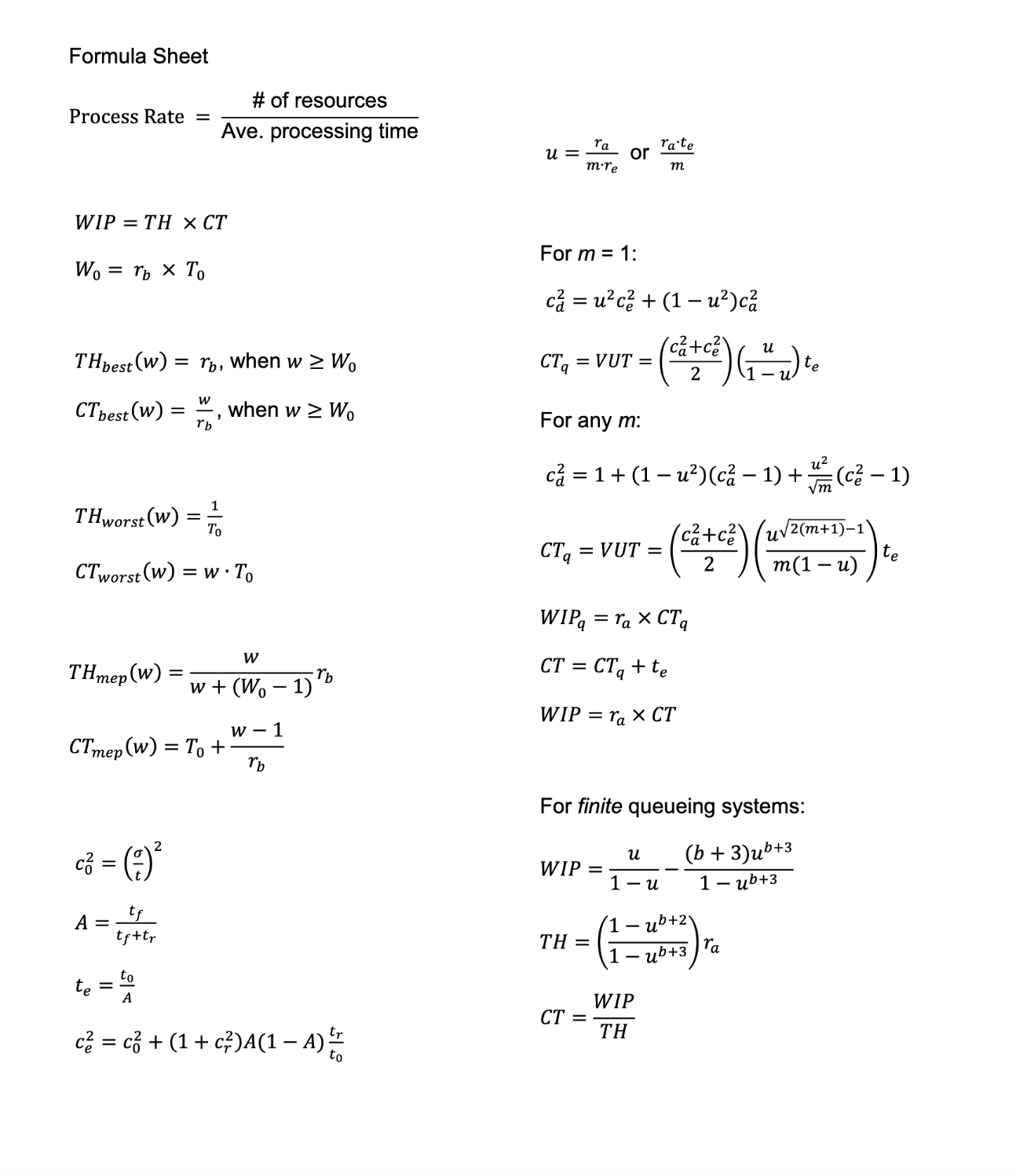Answered step by step
Verified Expert Solution
Question
1 Approved Answer
Please help me with this question and PLEASE PLEASE use the formula sheet that I attached, THANK YOU 2. Assume you are managing a manufacturing
Please help me with this question and PLEASE PLEASE use the formula sheet that I attached, THANK YOU

 2. Assume you are managing a manufacturing line consisting of two workstations: Decambering and Hemming. The mean effective process time of the first machine is 15 minutes and its coefficient of variation is 1 (i.e., exponential distribution). The second machine has the same coefficient of variation, but this machine takes 14 minutes to process a part. (a) If there is an infinite buffer between the machines, compute the expected WIP, CT, and TH. WIP: TH : CT: (b) Now assume that there is enough space for only 3 parts between the machines (Hint: the buffer size, b, is 3.) Recompute the expected WIP, CT, and TH. Compare with Part a. WIP: TH: CT: Formula Sheet ProcessRate=Ave.processingtime#ofresourcesu=mreraormrate WIP=THCTW0=rbT0 THbest(w)=rb,whenwW0CTbest(w)=rbw,whenwW0 THworst(w)=T01CTworst(w)=wT0 THmep(w)=w+(W01)wrbCTmep(w)=T0+rbw1 c02Atece2=(t)2=tf+trtf=At0=c02+(1+cr2)A(1A)t0tr For m=1 : cd2=u2ce2+(1u2)ca2CTq=VUT=(2ca2+ce2)(1uu)te For any m : cd2=1+(1u2)(ca21)+mu2(ce21)CTq=VUT=(2ca2+ce2)(m(1u)u2(m+1)1)teWIPq=raCTqCT=CTq+teWIP=raCT For finite queueing systems: WIP=1uu1ub+3(b+3)ub+3TH=(1ub+31ub+2)raCT=THWIP
2. Assume you are managing a manufacturing line consisting of two workstations: Decambering and Hemming. The mean effective process time of the first machine is 15 minutes and its coefficient of variation is 1 (i.e., exponential distribution). The second machine has the same coefficient of variation, but this machine takes 14 minutes to process a part. (a) If there is an infinite buffer between the machines, compute the expected WIP, CT, and TH. WIP: TH : CT: (b) Now assume that there is enough space for only 3 parts between the machines (Hint: the buffer size, b, is 3.) Recompute the expected WIP, CT, and TH. Compare with Part a. WIP: TH: CT: Formula Sheet ProcessRate=Ave.processingtime#ofresourcesu=mreraormrate WIP=THCTW0=rbT0 THbest(w)=rb,whenwW0CTbest(w)=rbw,whenwW0 THworst(w)=T01CTworst(w)=wT0 THmep(w)=w+(W01)wrbCTmep(w)=T0+rbw1 c02Atece2=(t)2=tf+trtf=At0=c02+(1+cr2)A(1A)t0tr For m=1 : cd2=u2ce2+(1u2)ca2CTq=VUT=(2ca2+ce2)(1uu)te For any m : cd2=1+(1u2)(ca21)+mu2(ce21)CTq=VUT=(2ca2+ce2)(m(1u)u2(m+1)1)teWIPq=raCTqCT=CTq+teWIP=raCT For finite queueing systems: WIP=1uu1ub+3(b+3)ub+3TH=(1ub+31ub+2)raCT=THWIP Step by Step Solution
There are 3 Steps involved in it
Step: 1

Get Instant Access to Expert-Tailored Solutions
See step-by-step solutions with expert insights and AI powered tools for academic success
Step: 2

Step: 3

Ace Your Homework with AI
Get the answers you need in no time with our AI-driven, step-by-step assistance
Get Started


